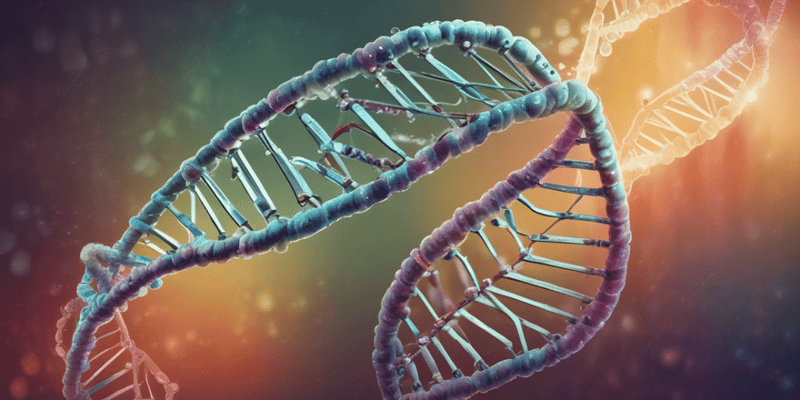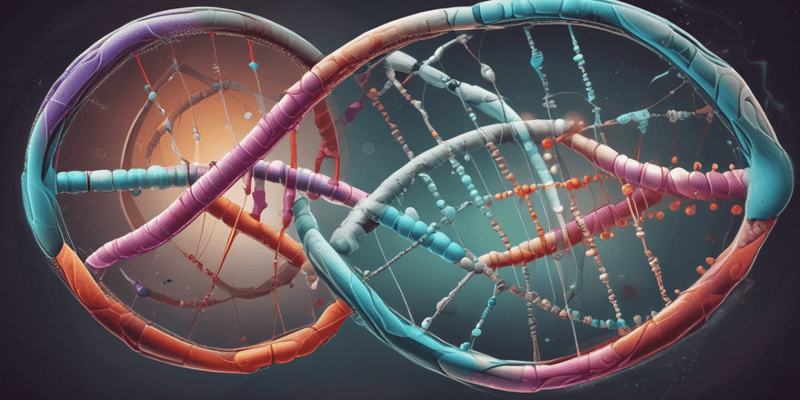21 Questions
What is the name of the molecule that stores information controlling cellular activity and the growth of an organism?
Deoxyribonucleic acid (DNA)
Who discovered the structure of DNA?
James Watson and Francis Crick
What was the significance of Rosalind Franklin's paper published in Nature?
It was the first publication of X-ray diffraction data that supported the Watson and Crick model
What is the relationship between the bases in DNA strands?
A=T and C=G
What happens when the two DNA strands are separated during DNA replication?
Each strand functions as a template for a complementary new chain
What was still unclear after the discovery of the double helix structure?
How DNA guides protein synthesis
What is the main difference between the DNA sequence of identical twins and that of other humans?
Identical twins have the same DNA sequence as each other
What is the process of making proteins referred to as?
Protein Synthesis
What is the primary role of DNA in an organism?
To make an organism grow and develop
What percentage of human DNA codes for proteins?
Fewer than 2%
Who jointly received the Nobel Prize in Physiology or Medicine in 1962?
Watson, Crick, and Wilkins
What is the significance of DNA replication?
To pass on genetic information from generation to generation
Where is DNA located in a cell?
In the nucleus
What is the unique aspect of an individual's genetic code?
The sequence of nucleotides in their DNA
What is the shape of the DNA molecule?
A double helix
What is the sugar molecule found in DNA?
Deoxyribose
Which bases are purines?
Guanine and adenine
What is the difference between the DNA of different organisms?
The sequence of nucleotides
How many hydrogen bonds hold together guanine and cytosine?
Three
What is the basis of the genetic code?
The sequence of nucleotides
What is the result of the process demonstrated by Crick and Brenner in 1961?
The transfer of genetic information from DNA to RNA
Study Notes
DNA Structure and Function
- DNA is known as "the code of life" as it stores information that controls cellular activity and the growth of an entire organism. This genetic information is encoded in the sequence of nucleotides, which are the building blocks of DNA.
- Two nucleic acids found in cells are Deoxyribonucleic acid (DNA) and Ribonucleic acid (RNA). DNA is a double-stranded molecule, whereas RNA is usually single-stranded. The double helix structure of DNA is formed by the pairing of two complementary strands, held together by hydrogen bonds between the nucleotides.
- The structure of DNA allows for the storage and transmission of genetic information from one generation to the next. The sequence of nucleotides determines the genetic code, which is used to synthesize proteins and other molecules essential for cellular function.
Discovery of DNA Structure
- In 1953, James Watson and Francis Crick suggested the first accurate model of DNA structure based on X-ray diffraction data taken by Rosalind Franklin.
- Experimental evidence for Watson and Crick's model was published in a series of five articles in Nature.
- Franklin's paper was the first publication of X-ray diffraction data that supported the Watson and Crick model.
Genetic Replication
- Watson and Crick expanded on their views on DNA replication in a second article published in Nature on May 30, 1953.
- The bases' pairing, i.e. A=T and C=G, showed that given a sequence of bases in one strand, the other strand could be determined automatically.
- When the two strands were separated, each one functioned as a template for a complementary new chain, allowing each strand to reproduce.
Protein Synthesis
- Francis Crick and Sydney Brenner demonstrated in 1961 that a triplet code (called a codon) was utilized to read genetic material in DNA and transfer this information from the nucleus to the cytoplasm via RNA, where proteins are created.
- The sequence of bases in DNA constitutes a code that can be used to store and convey genetic information.
Location and Shape of DNA
- DNA is located in the nucleus of a cell where it forms a vital part of the chromosomes that make up the chromatin network.
- The DNA molecule is made up of two strands that wind around each other to form a double helix, a three-dimensional spiral.
- The strands are known as the sugar-phosphate backbone.
Components of DNA
- A DNA molecule is made up of building blocks called nucleotides.
- Each nucleotide is made up of a sugar molecule (deoxyribose), a phosphate molecule, and a nitrogenous base (adenine, thymine, guanine, or cytosine).
- These four bases form the basis of the genetic code, which tells cells how to synthesize proteins and other enzymes.
Classification of Base Pairs
- There are two sets of nitrogenous bases termed purines (guanine and adenine) and pyrimidines (cytosine and thymine in DNA, or Uracil in RNA).
Differences between Organisms and their DNA
- The DNA of all animals and plants is made up of the same four nucleotides.
- What makes organisms different from each other is the sequence in which the nucleotides are strung together.
- An organism's specific genetic code is determined by the sequence of the nucleotides in their DNA.
The Role of DNA
- DNA is important because it contains the instructions needed for an organism to grow and develop by coding for protein synthesis.
- It carries all the genetic information that makes each individual unique.
- It replicates itself so that genetic information can be passed on from generation to generation.
Non-Coding DNA
- Fewer than 2% of human DNA codes for proteins; the rest comprises of non-coding DNA.
Learn about DNA, the molecule of life, and its discovery by James Watson and Francis Crick. Understand the structure and importance of DNA in cellular activity.
Make Your Own Quizzes and Flashcards
Convert your notes into interactive study material.
Get started for free



